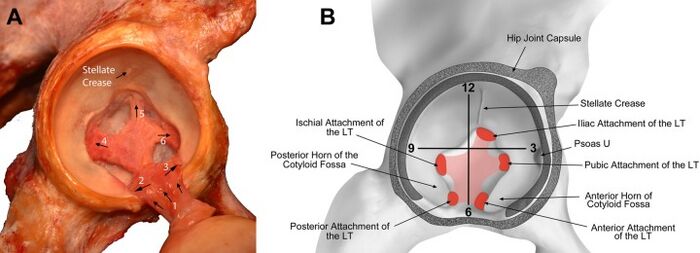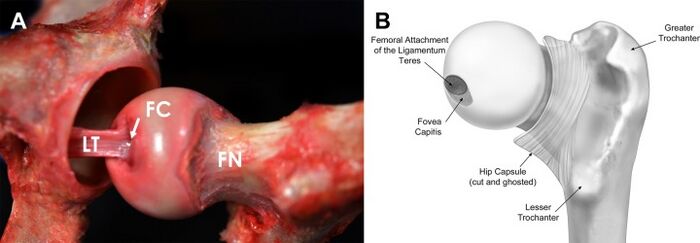Ligamentum Teres
Original Editor - Carina Therese Magtibay
Top Contributors - Carina Therese Magtibay
Description[edit | edit source]
The Ligamentum Teres, also known as ligamentum femoris capitis, is an intra-articular extrasynovial ligament of the hip with acetabular and femoral attachments.[1] Earlier research described it as a vestigial structure [2][3], however, recent studies have suggested the ligamentum teres to have an important function in proprioception, nociception, and as a secondary stabilizer of the hip joint. [4][5][6]
A histology study found that ligamentum teres is composed of a single layer of investing synovium, with an underlying framework of connective tissue. Within the connective tissue are:[7]
- blood vessels
- adipose tissue
- collagen fibers
- fibrous tissue
- nerve bundles
Attachments[edit | edit source]
Origin: acetabular fossa and transverse acetabular ligament

Insertion: fovea capitis of the posteroinferior aspect of the femoral head
Function[edit | edit source]
Postulated functions of the ligamentum teres:[7]
| Mechanical | 1. Stability | • Rich in collagen and fibrous stiffness comparable to cruciate ligaments of the knee
• Able to show adaptive changes in response to external stress |
|---|---|---|
| 2. Proprioception and fine-coordination | • Nerve bundles present in all specimens, likely including somatosensory afferents contributing to the secondary joint protection system | |
| Biological | 1. Vascular supply | • Blood vessels of varying sizes scattered throughout structure
• Layer of encircling fat around small arteries providing structural support to maintain lumen patency |
| 2. Nociception | • Nerve bundles present in all specimens, likely including pain fibers contributing to hip pain in ligamentum tears or ruptures |
- Maximum ligamentum teres tension to occur when the hip is in: [8]
- 90 ° flexion, 0 ° adduction, and 60 ° external rotation
- 20 ° extension, 0 ° adduction, and 60 ° internal rotation
- These two positions of maximal tension were similar with respect to hip orientation to that obtained when an individual: (1) squats and (2) attempts to cross one leg behind the other when standing
Assessment[edit | edit source]
Clinical Presentation of ligamentum teres pathology:[9][10]
- persistent localized groin pain
- hip instability
- mechanical symptoms (catching, popping, locking, giving way)
Note: Unique signs and symptoms for LT pathology are difficult to identify because LT pathology rarely occurs in isolation, but is usually associated with significant labral and cartilage pathology.[8]
Ligamentum Teres Special Test[11]
- Used for diagnosing tears of the ligamentum teres
- This test was found to be reproducible and accurate, with moderate to high inter-observer reliability and sensitivity and specificity values of 0.90% and 0.85, respectively.
- Patient position: supine and in 70° of hip flexion and 30° short of full abduction
- Test: The hip is externally and internally rotated to its limits of motion
- Positive finding: reproduction of pain on either internal or external rotation at the end range of motion
Treatment[edit | edit source]
Ligamentum teres pathology rarely occurs in isolation, thus, treatment is usually directed at the impairment associated with the accompanying pathology. Typically conservative treatment addresses range deficits associated with Femoroacetabular Impingement or instability associated with hip dysplasia. [8]
As for surgical treatment, a systematic review suggests that debridement of the ligamentum is indicated for short-term relief of hip pain caused by partial ligamentum tears. On the other hand, reconstruction was indicated for complete ligamentum teres tears[9][13]
Physiotherapy Management[edit | edit source]
Physiotherapy is started immediately following arthroscopic ligamentum teres reconstruction while the patient is wearing a brace that prevents hip hyperextension and external rotation. Physiotherapy management includes: [13]
- Passive range of motion is indicated to avoid intra-articular adhesions.
- “Toe-touch” weight bearing is done for the first two weeks and can be progressed to partial weight bearing with the brace for an additional four weeks.
- Return to play is allowed at 5 months postoperatively.
References[edit | edit source]
- ↑ Rosinsky PJ, Shapira J, Lall AC, Domb BG. All about the ligamentum teres: from biomechanical role to surgical reconstruction. JAAOS-Journal of the American Academy of Orthopaedic Surgeons. 2020 Apr 15;28(8):e328-39.
- ↑ Ganz R, Gill TJ, Gautier E, Ganz K, Krügel N, Berlemann U. Surgical dislocation of the adult hip: a technique with full access to the femoral head and acetabulum without the risk of avascular necrosis. The Journal of Bone & Joint Surgery British Volume. 2001 Nov 1;83(8):1119-24.
- ↑ Gray AJ, Villar RN. The ligamentum teres of the hip: an arthroscopic classification of its pathology. Arthroscopy: The Journal of Arthroscopic & Related Surgery. 1997 Oct 1;13(5):575-8.
- ↑ Mikula JD, Slette EL, Chahla J, Brady AW, Locks R, Trindade CA, Rasmussen MT, LaPrade RF, Philippon MJ. Quantitative anatomic analysis of the native ligamentum teres. Orthopaedic Journal of Sports Medicine. 2017 Feb 24;5(2):2325967117691480.
- ↑ Van Arkel RJ, Amis AA, Cobb JP, Jeffers JR. The capsular ligaments provide more hip rotational restraint than the acetabular labrum and the ligamentum teres: an experimental study. The bone & joint journal. 2015 Apr 1;97(4):484-91.
- ↑ Martin HD, Hatem MA, Kivlan BR, Martin RL. Function of the ligamentum teres in limiting hip rotation: a cadaveric study. Arthroscopy: The Journal of Arthroscopic & Related Surgery. 2014 Sep 1;30(9):1085-91.
- ↑ 7.0 7.1 Dehao BW, Bing TK, Young JL. Understanding the ligamentum teres of the hip: a histological study. Acta Ortopédica Brasileira. 2015 Jan;23:29-33.
- ↑ 8.0 8.1 8.2 Martin RL, McDonough C, Enseki K, Kohreiser D, Kivlan BR. Clinical relevance of the ligamentum teres: a literature review. International journal of sports physical therapy. 2019 Jun;14(3):459.
- ↑ 9.0 9.1 Phillips M, Philippon MJ, Letkemann S, Simunovic N, Ayeni OR. Ligamentum teres injuries of the hip: a systematic review examining surgical indications, treatment options, and outcomes. Arthroscopy: The Journal of Arthroscopic & Related Surgery. 2014 Dec 1;30(12):1634-41.
- ↑ Byrd JT, Jones KS. Traumatic rupture of the ligamentum teres as a source of hip pain. Arthroscopy: The Journal of Arthroscopic & Related Surgery. 2004 Apr 1;20(4):385-91.
- ↑ O’Donnell J, Economopoulos K, Singh P, Bates D, Pritchard M. The ligamentum teres test: a novel and effective test in diagnosing tears of the ligamentum teres. The American journal of sports medicine. 2014 Jan;42(1):138-43.
- ↑ Physio Network. The Ligamentum Teres Test - A Special Test for Hip Pain. Available from https://www.youtube.com/watch?v=A2pu9PC9OkE [last accessed 15/02/2024]
- ↑ 13.0 13.1 Kraeutler MJ, Garabekyan T, Pascual-Garrido C, Mei-Dan O. Ligamentum teres tendinopathy and tears. Muscles, Ligaments and Tendons Journal. 2016 Jul;6(3):337.







